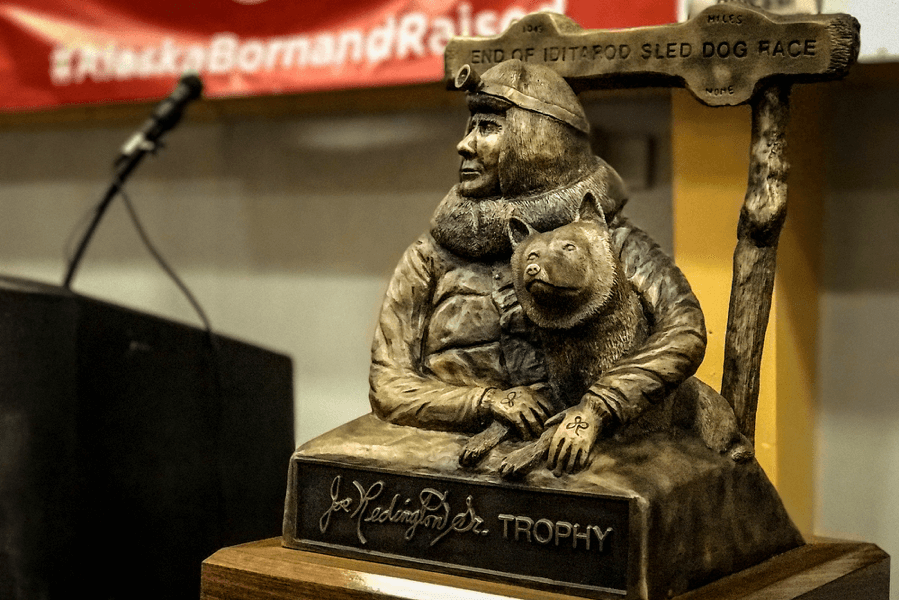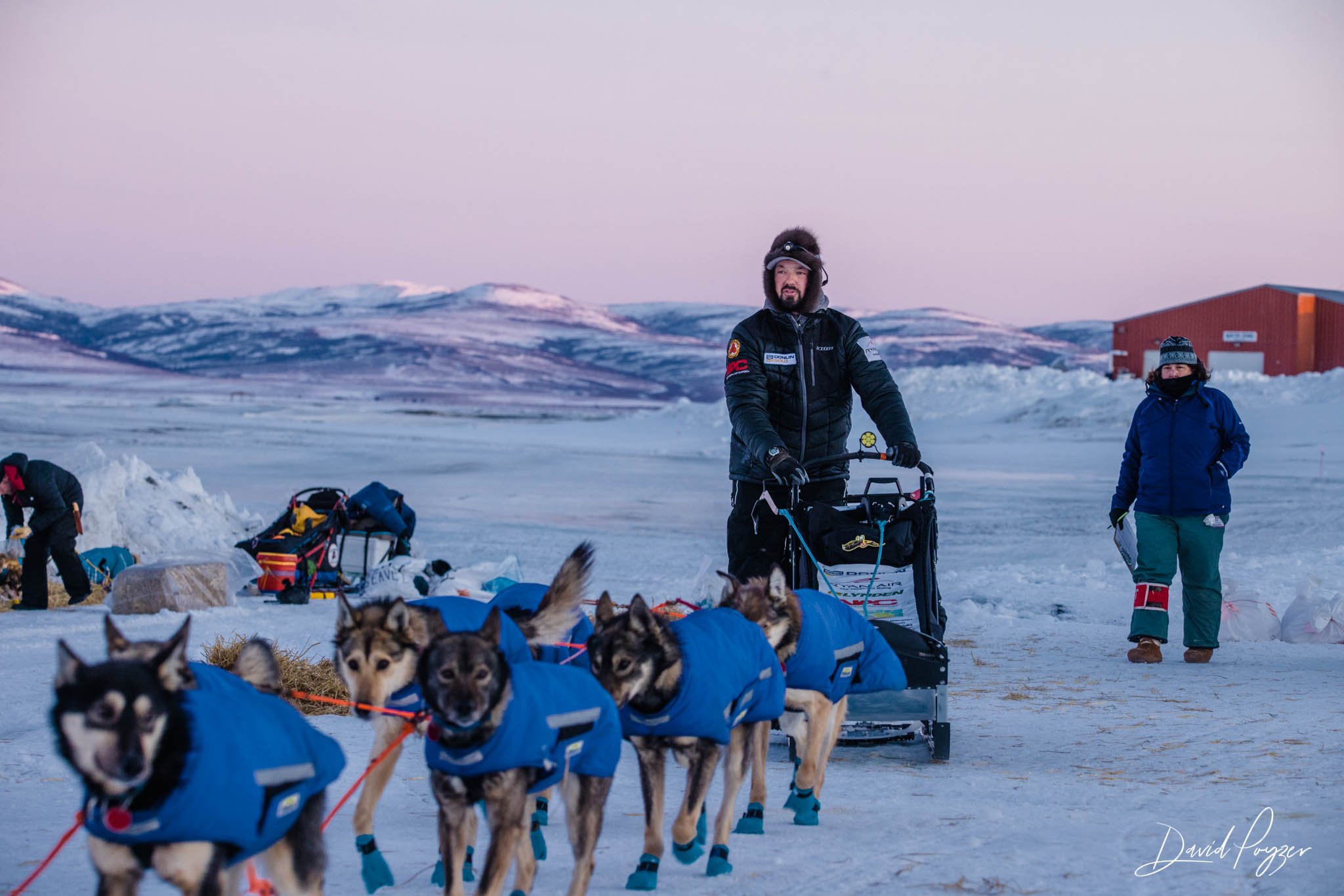Racing History
Petter Karlsson and his team of superstar dogs.
Credit: Peter Varga / Tying Knots Art Studio
Sled dogs have coexisted and cooperated in partnership with humans for many thousands of years in the northern regions of North America and Siberia. Some anthropologists suggest that human habitation and survival in the Arctic would not have been possible without sled dogs.
In the Southwest of what is now the United States, the first Spanish explorers encountered Indians who used dogs as draft animals pulling travois. They remarked that these dogs were an integral part of the Indians’ culture.
In fact, in many North American Indian cultures, the relationship with dogs was central to their style of life and the introduction of horses occurred in parallel without replacing or diminishing the cultural importance of dogs as respected associates and partners.
Sled dog activities as recreation and friendly competition may have existed for almost as long as the relationship between dogs and humans in the regions where snow was a seasonal probability.
The first written account of a race was an informal challenge between travelers on the route from Winnipeg to St. Paul in the 1850s.
In 1886, the first Saint Paul Winter Carnival featured sled dog races and ski competitions as part of the festival to glorify the attractions of winter in Minnesota—this event is still going on today!
The most memorable was the 1917 race from Winnipeg to Saint Paul on which a recent Walt Disney movie (Iron Will) was loosely based. Different from the story in the movie, the race that year was actually won by Albert Campbell, a Metis from The Pas, Manitoba followed by his brother in second place.
Albert Campbell from The Pas, Manitoba, winner of the 1917 St Paul Winter Carnival Winnipeg to St.Paul race
At the turn of the century, the attention of the outside world had been drawn to the far North, Alaska and the Yukon, by the Gold Rush. The first major sled dog races to receive worldwide attention were organized in Nome, Alaska as the All-Alaska Sweepstakes.
Scotty Allan was a Scotsman who had come to North America as a handler for workhorses and then joined the prospectors in the Klondike as a dog musher freighting supplies into the remote mines and camps. He played a major role in the organization and focus of the early races in Alaska.
It was Scotty Allan’s experience and understanding of working animals that helped to determine the course of the first races in Nome and of the sport these races inspired, insisting on the paramount importance of dog care.
The All Alaska Sweepstakes races and the concurrent festivities were reported in the New York Times and other major newspapers. In addition to Scotty Allan, another musher who first came to prominence in Nome, Leonard Seppala of Norway, went on to have a major influence on the development of the sport.
Norwegian Leonard Seppala and his dog team in Alaska.
The attention given to mushing and its popularity in the news media made it a natural consequence that the first Winter Olympics held in North America would feature sled dog racing as representative of sports that originated on this continent.
The 1932 Lake Placid Winter Olympic Games included Sled Dog Racing as a Demonstration Sport. The contestants ran 7-dog teams 25 miles each day for two days. The winner was a French Canadian from The Pas, Manitoba, Emile St. Goddard whose duels with Leonard Seppala on the trails were already legend. The second was the Norwegian by way of Alaska, Leonard Seppala, and third was a Russian by way of Brooklyn and Manitoba, Shorty Russick.
Despite the international character of the participants in the race in Lake Placid there was little activity outside North America except in Norway where the use of dogs for military supply and ambulance work beginning at the time of the First World War had been transformed into a sport. (Sled dogs were also used during WWI in France and the SudTirol/Alto Adige region of Italy.)
The influence of Norwegian explorers Nansen and Amundsen who used sled dogs in the North and South Polar regions was also important in establishing a Scandinavian sled dog sport. In the 1952 Oslo Olympics sled dogs were featured again as a Demonstration Sport this time in the form of pulka races where the driver accompanies the dogs on skis behind a toboggan or pulka.
Mushing in its many different forms has gradually spread around the world since that period. In 1992 the International Federation of Sleddog Sports was officially incorporated as a way to focus the efforts of many national, local and international organizations on the goal of Olympic recognition and alignment of mushing with other mainstream sports. IFSS is recognized in all countries as the world governing body of sled dog sports.
In the 1950s and 60s, the use of working dogs was gradually disappearing throughout North America. Airplanes and snowmobiles eliminated the need for sled dogs as transportation.
One musher, Joe Redington Senior and one race, the Iditarod, more than any other factors were responsible for preserving and reinvigorating mushing and continuing its traditions. Critics at the time said he and Dick Mackey started and put so much effort into the Iditarod because their dogs and teams were too slow to be competitive in the existing sprint races like the Open North American Championship and Anchorage Fur Rondy.
Fact is Joe Redington more than anyone else sustained and revived the true spirit of dog mushing as a way of life and the joyful working partnership with sled dogs that it had always been, at a time when, with the use of snow machines and other machinery, the dogs’ traditional role in transportation and subsistence and the tradition itself was disappearing.
The Iditarod is not simply the most reported and recognized sled dog race in the world; it is a living monument to Joe and his vision and appreciation of the spirit of mushing.
Every winner of the Iditarod race receives a huge trophy like this that weighs well over 40 lb. and depicts Joe Redington Sr. with his lead dog – and a cool detail, the headlamp works!
Joe Redington Sr. is not only legendary because he is the “father of the Iditarod” – Redington Sr. once hooked up 200 sled dogs to a school bus and ran ‘the team’ down the main road in Knik where he lived! He also ran sled dogs with legendary dog musher and 3 x Iditarod Champion, Susan Butcher, to the top of Mount Denali (earlier known as Mount McKinley)—North America’s highest mountain!
We want to thank Tim White for his significant contributions to this story.






































